Child and Adolescent Development
VerifiedAdded on 2023/01/24
|12
|3210
|76
AI Summary
This paper discusses the development themes and solutions for child and adolescent development scenarios. It explores the impact of family, peers, media, and schooling on a child's behavior and provides strategies to improve academic performance and social well-being.
Contribute Materials
Your contribution can guide someone’s learning journey. Share your
documents today.
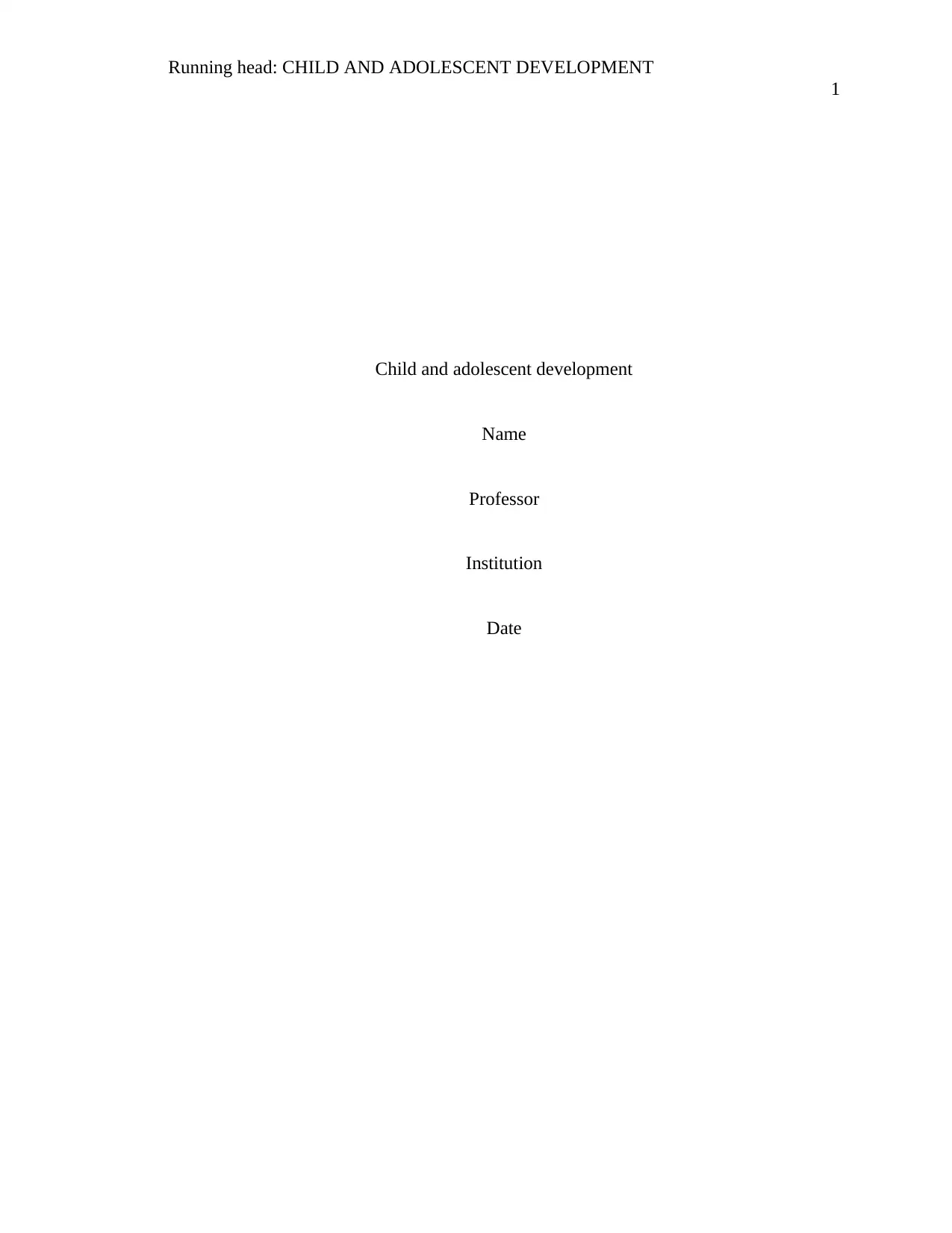
Running head: CHILD AND ADOLESCENT DEVELOPMENT
1
Child and adolescent development
Name
Professor
Institution
Date
1
Child and adolescent development
Name
Professor
Institution
Date
Secure Best Marks with AI Grader
Need help grading? Try our AI Grader for instant feedback on your assignments.
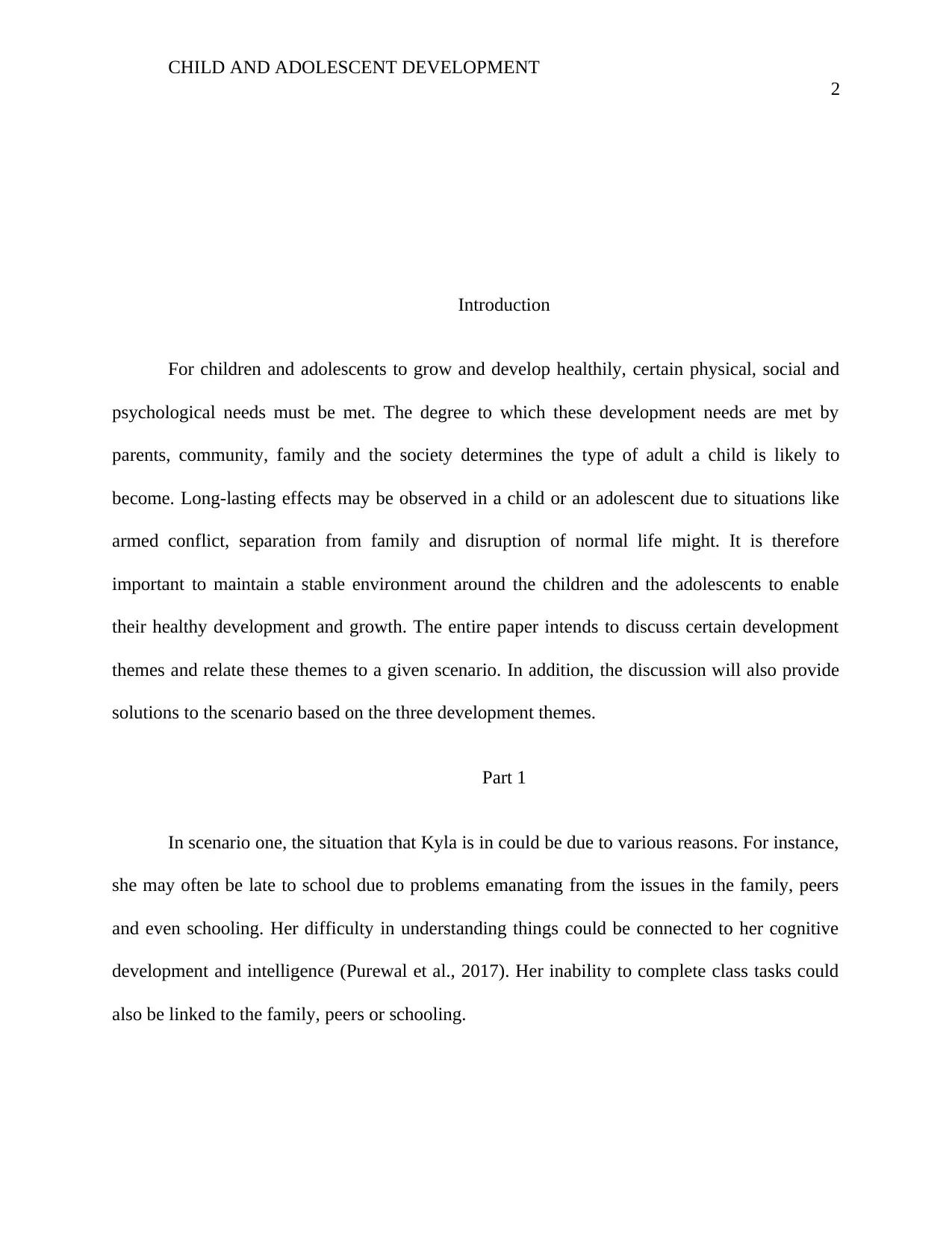
CHILD AND ADOLESCENT DEVELOPMENT
2
Introduction
For children and adolescents to grow and develop healthily, certain physical, social and
psychological needs must be met. The degree to which these development needs are met by
parents, community, family and the society determines the type of adult a child is likely to
become. Long-lasting effects may be observed in a child or an adolescent due to situations like
armed conflict, separation from family and disruption of normal life might. It is therefore
important to maintain a stable environment around the children and the adolescents to enable
their healthy development and growth. The entire paper intends to discuss certain development
themes and relate these themes to a given scenario. In addition, the discussion will also provide
solutions to the scenario based on the three development themes.
Part 1
In scenario one, the situation that Kyla is in could be due to various reasons. For instance,
she may often be late to school due to problems emanating from the issues in the family, peers
and even schooling. Her difficulty in understanding things could be connected to her cognitive
development and intelligence (Purewal et al., 2017). Her inability to complete class tasks could
also be linked to the family, peers or schooling.
2
Introduction
For children and adolescents to grow and develop healthily, certain physical, social and
psychological needs must be met. The degree to which these development needs are met by
parents, community, family and the society determines the type of adult a child is likely to
become. Long-lasting effects may be observed in a child or an adolescent due to situations like
armed conflict, separation from family and disruption of normal life might. It is therefore
important to maintain a stable environment around the children and the adolescents to enable
their healthy development and growth. The entire paper intends to discuss certain development
themes and relate these themes to a given scenario. In addition, the discussion will also provide
solutions to the scenario based on the three development themes.
Part 1
In scenario one, the situation that Kyla is in could be due to various reasons. For instance,
she may often be late to school due to problems emanating from the issues in the family, peers
and even schooling. Her difficulty in understanding things could be connected to her cognitive
development and intelligence (Purewal et al., 2017). Her inability to complete class tasks could
also be linked to the family, peers or schooling.
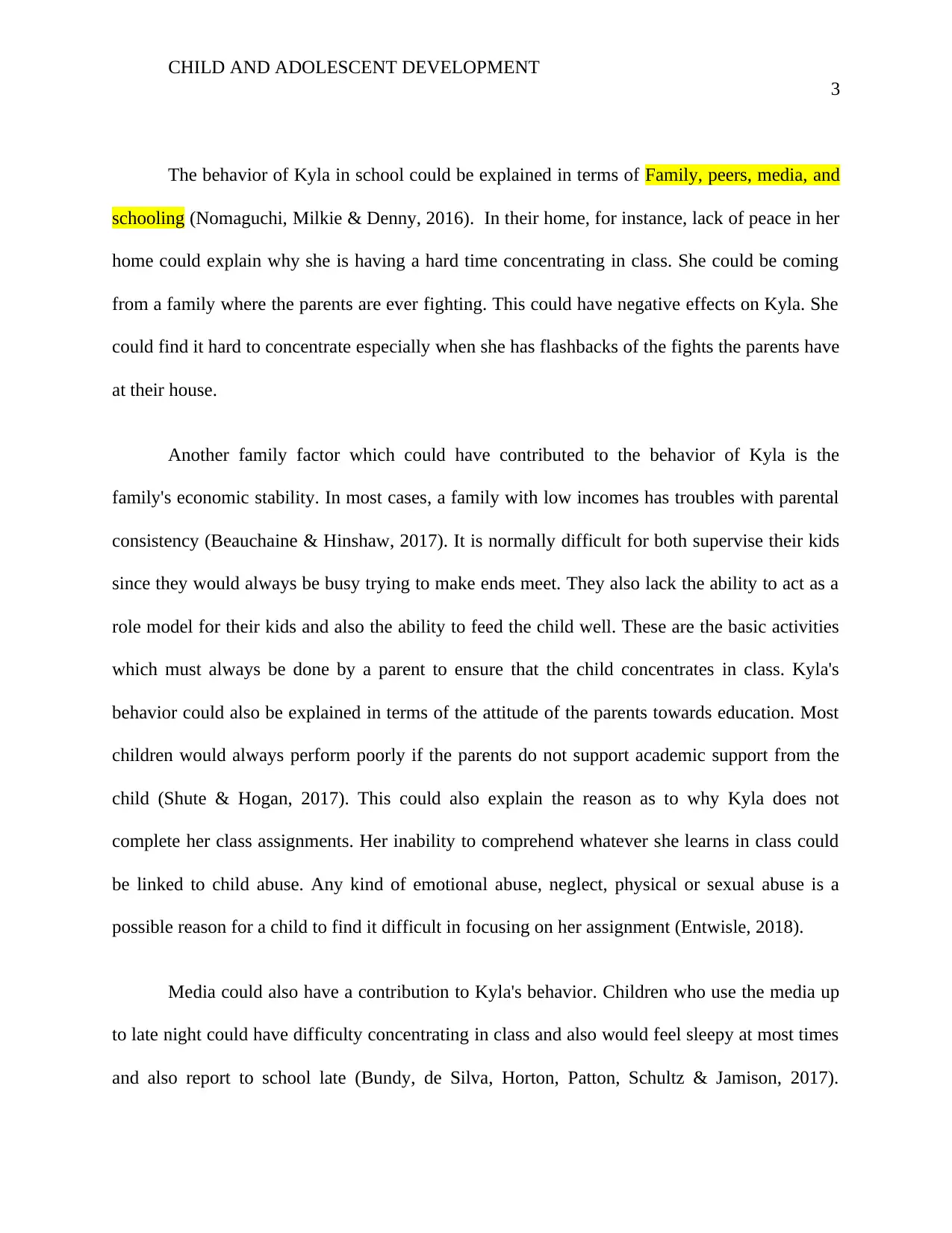
CHILD AND ADOLESCENT DEVELOPMENT
3
The behavior of Kyla in school could be explained in terms of Family, peers, media, and
schooling (Nomaguchi, Milkie & Denny, 2016). In their home, for instance, lack of peace in her
home could explain why she is having a hard time concentrating in class. She could be coming
from a family where the parents are ever fighting. This could have negative effects on Kyla. She
could find it hard to concentrate especially when she has flashbacks of the fights the parents have
at their house.
Another family factor which could have contributed to the behavior of Kyla is the
family's economic stability. In most cases, a family with low incomes has troubles with parental
consistency (Beauchaine & Hinshaw, 2017). It is normally difficult for both supervise their kids
since they would always be busy trying to make ends meet. They also lack the ability to act as a
role model for their kids and also the ability to feed the child well. These are the basic activities
which must always be done by a parent to ensure that the child concentrates in class. Kyla's
behavior could also be explained in terms of the attitude of the parents towards education. Most
children would always perform poorly if the parents do not support academic support from the
child (Shute & Hogan, 2017). This could also explain the reason as to why Kyla does not
complete her class assignments. Her inability to comprehend whatever she learns in class could
be linked to child abuse. Any kind of emotional abuse, neglect, physical or sexual abuse is a
possible reason for a child to find it difficult in focusing on her assignment (Entwisle, 2018).
Media could also have a contribution to Kyla's behavior. Children who use the media up
to late night could have difficulty concentrating in class and also would feel sleepy at most times
and also report to school late (Bundy, de Silva, Horton, Patton, Schultz & Jamison, 2017).
3
The behavior of Kyla in school could be explained in terms of Family, peers, media, and
schooling (Nomaguchi, Milkie & Denny, 2016). In their home, for instance, lack of peace in her
home could explain why she is having a hard time concentrating in class. She could be coming
from a family where the parents are ever fighting. This could have negative effects on Kyla. She
could find it hard to concentrate especially when she has flashbacks of the fights the parents have
at their house.
Another family factor which could have contributed to the behavior of Kyla is the
family's economic stability. In most cases, a family with low incomes has troubles with parental
consistency (Beauchaine & Hinshaw, 2017). It is normally difficult for both supervise their kids
since they would always be busy trying to make ends meet. They also lack the ability to act as a
role model for their kids and also the ability to feed the child well. These are the basic activities
which must always be done by a parent to ensure that the child concentrates in class. Kyla's
behavior could also be explained in terms of the attitude of the parents towards education. Most
children would always perform poorly if the parents do not support academic support from the
child (Shute & Hogan, 2017). This could also explain the reason as to why Kyla does not
complete her class assignments. Her inability to comprehend whatever she learns in class could
be linked to child abuse. Any kind of emotional abuse, neglect, physical or sexual abuse is a
possible reason for a child to find it difficult in focusing on her assignment (Entwisle, 2018).
Media could also have a contribution to Kyla's behavior. Children who use the media up
to late night could have difficulty concentrating in class and also would feel sleepy at most times
and also report to school late (Bundy, de Silva, Horton, Patton, Schultz & Jamison, 2017).
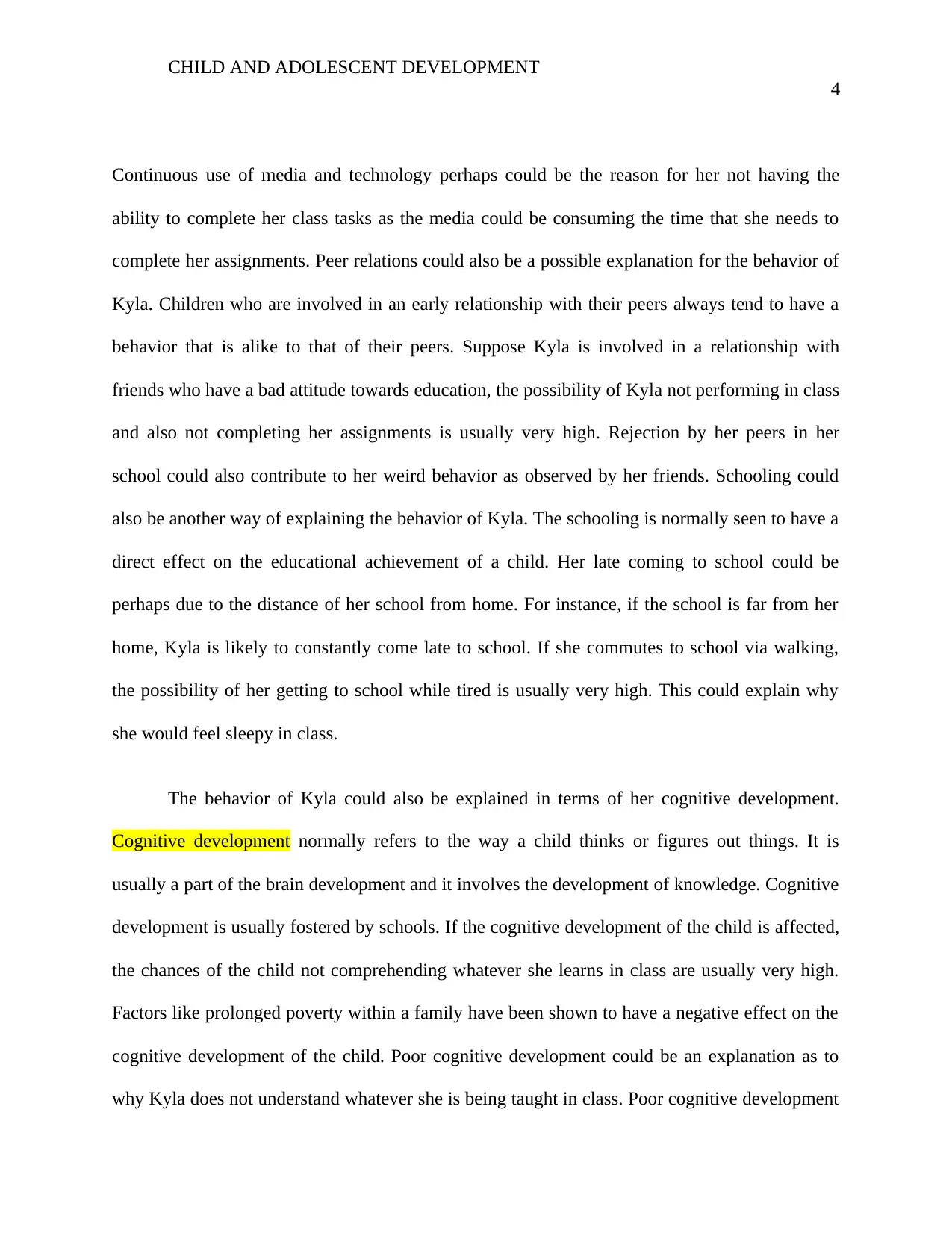
CHILD AND ADOLESCENT DEVELOPMENT
4
Continuous use of media and technology perhaps could be the reason for her not having the
ability to complete her class tasks as the media could be consuming the time that she needs to
complete her assignments. Peer relations could also be a possible explanation for the behavior of
Kyla. Children who are involved in an early relationship with their peers always tend to have a
behavior that is alike to that of their peers. Suppose Kyla is involved in a relationship with
friends who have a bad attitude towards education, the possibility of Kyla not performing in class
and also not completing her assignments is usually very high. Rejection by her peers in her
school could also contribute to her weird behavior as observed by her friends. Schooling could
also be another way of explaining the behavior of Kyla. The schooling is normally seen to have a
direct effect on the educational achievement of a child. Her late coming to school could be
perhaps due to the distance of her school from home. For instance, if the school is far from her
home, Kyla is likely to constantly come late to school. If she commutes to school via walking,
the possibility of her getting to school while tired is usually very high. This could explain why
she would feel sleepy in class.
The behavior of Kyla could also be explained in terms of her cognitive development.
Cognitive development normally refers to the way a child thinks or figures out things. It is
usually a part of the brain development and it involves the development of knowledge. Cognitive
development is usually fostered by schools. If the cognitive development of the child is affected,
the chances of the child not comprehending whatever she learns in class are usually very high.
Factors like prolonged poverty within a family have been shown to have a negative effect on the
cognitive development of the child. Poor cognitive development could be an explanation as to
why Kyla does not understand whatever she is being taught in class. Poor cognitive development
4
Continuous use of media and technology perhaps could be the reason for her not having the
ability to complete her class tasks as the media could be consuming the time that she needs to
complete her assignments. Peer relations could also be a possible explanation for the behavior of
Kyla. Children who are involved in an early relationship with their peers always tend to have a
behavior that is alike to that of their peers. Suppose Kyla is involved in a relationship with
friends who have a bad attitude towards education, the possibility of Kyla not performing in class
and also not completing her assignments is usually very high. Rejection by her peers in her
school could also contribute to her weird behavior as observed by her friends. Schooling could
also be another way of explaining the behavior of Kyla. The schooling is normally seen to have a
direct effect on the educational achievement of a child. Her late coming to school could be
perhaps due to the distance of her school from home. For instance, if the school is far from her
home, Kyla is likely to constantly come late to school. If she commutes to school via walking,
the possibility of her getting to school while tired is usually very high. This could explain why
she would feel sleepy in class.
The behavior of Kyla could also be explained in terms of her cognitive development.
Cognitive development normally refers to the way a child thinks or figures out things. It is
usually a part of the brain development and it involves the development of knowledge. Cognitive
development is usually fostered by schools. If the cognitive development of the child is affected,
the chances of the child not comprehending whatever she learns in class are usually very high.
Factors like prolonged poverty within a family have been shown to have a negative effect on the
cognitive development of the child. Poor cognitive development could be an explanation as to
why Kyla does not understand whatever she is being taught in class. Poor cognitive development
Secure Best Marks with AI Grader
Need help grading? Try our AI Grader for instant feedback on your assignments.
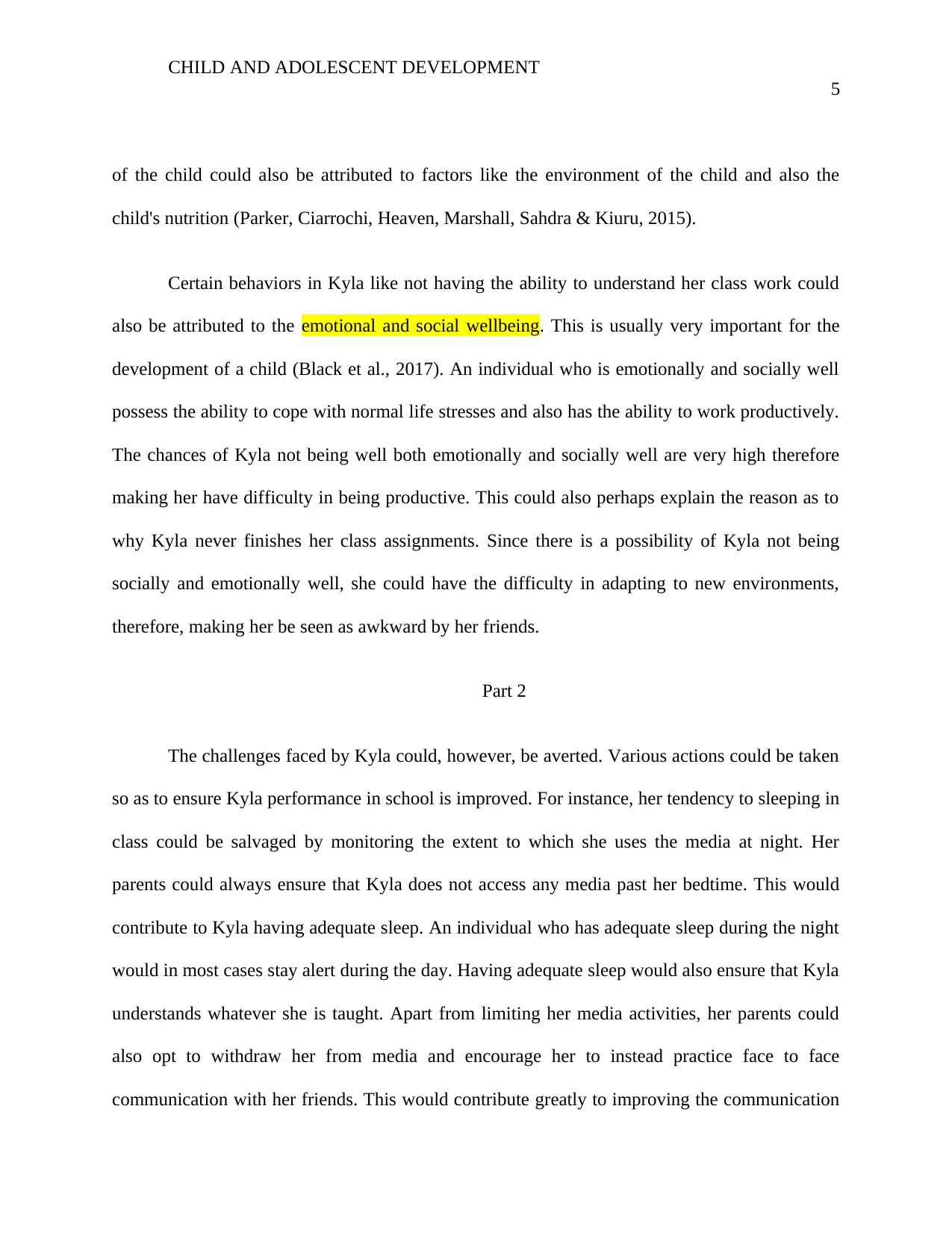
CHILD AND ADOLESCENT DEVELOPMENT
5
of the child could also be attributed to factors like the environment of the child and also the
child's nutrition (Parker, Ciarrochi, Heaven, Marshall, Sahdra & Kiuru, 2015).
Certain behaviors in Kyla like not having the ability to understand her class work could
also be attributed to the emotional and social wellbeing. This is usually very important for the
development of a child (Black et al., 2017). An individual who is emotionally and socially well
possess the ability to cope with normal life stresses and also has the ability to work productively.
The chances of Kyla not being well both emotionally and socially well are very high therefore
making her have difficulty in being productive. This could also perhaps explain the reason as to
why Kyla never finishes her class assignments. Since there is a possibility of Kyla not being
socially and emotionally well, she could have the difficulty in adapting to new environments,
therefore, making her be seen as awkward by her friends.
Part 2
The challenges faced by Kyla could, however, be averted. Various actions could be taken
so as to ensure Kyla performance in school is improved. For instance, her tendency to sleeping in
class could be salvaged by monitoring the extent to which she uses the media at night. Her
parents could always ensure that Kyla does not access any media past her bedtime. This would
contribute to Kyla having adequate sleep. An individual who has adequate sleep during the night
would in most cases stay alert during the day. Having adequate sleep would also ensure that Kyla
understands whatever she is taught. Apart from limiting her media activities, her parents could
also opt to withdraw her from media and encourage her to instead practice face to face
communication with her friends. This would contribute greatly to improving the communication
5
of the child could also be attributed to factors like the environment of the child and also the
child's nutrition (Parker, Ciarrochi, Heaven, Marshall, Sahdra & Kiuru, 2015).
Certain behaviors in Kyla like not having the ability to understand her class work could
also be attributed to the emotional and social wellbeing. This is usually very important for the
development of a child (Black et al., 2017). An individual who is emotionally and socially well
possess the ability to cope with normal life stresses and also has the ability to work productively.
The chances of Kyla not being well both emotionally and socially well are very high therefore
making her have difficulty in being productive. This could also perhaps explain the reason as to
why Kyla never finishes her class assignments. Since there is a possibility of Kyla not being
socially and emotionally well, she could have the difficulty in adapting to new environments,
therefore, making her be seen as awkward by her friends.
Part 2
The challenges faced by Kyla could, however, be averted. Various actions could be taken
so as to ensure Kyla performance in school is improved. For instance, her tendency to sleeping in
class could be salvaged by monitoring the extent to which she uses the media at night. Her
parents could always ensure that Kyla does not access any media past her bedtime. This would
contribute to Kyla having adequate sleep. An individual who has adequate sleep during the night
would in most cases stay alert during the day. Having adequate sleep would also ensure that Kyla
understands whatever she is taught. Apart from limiting her media activities, her parents could
also opt to withdraw her from media and encourage her to instead practice face to face
communication with her friends. This would contribute greatly to improving the communication
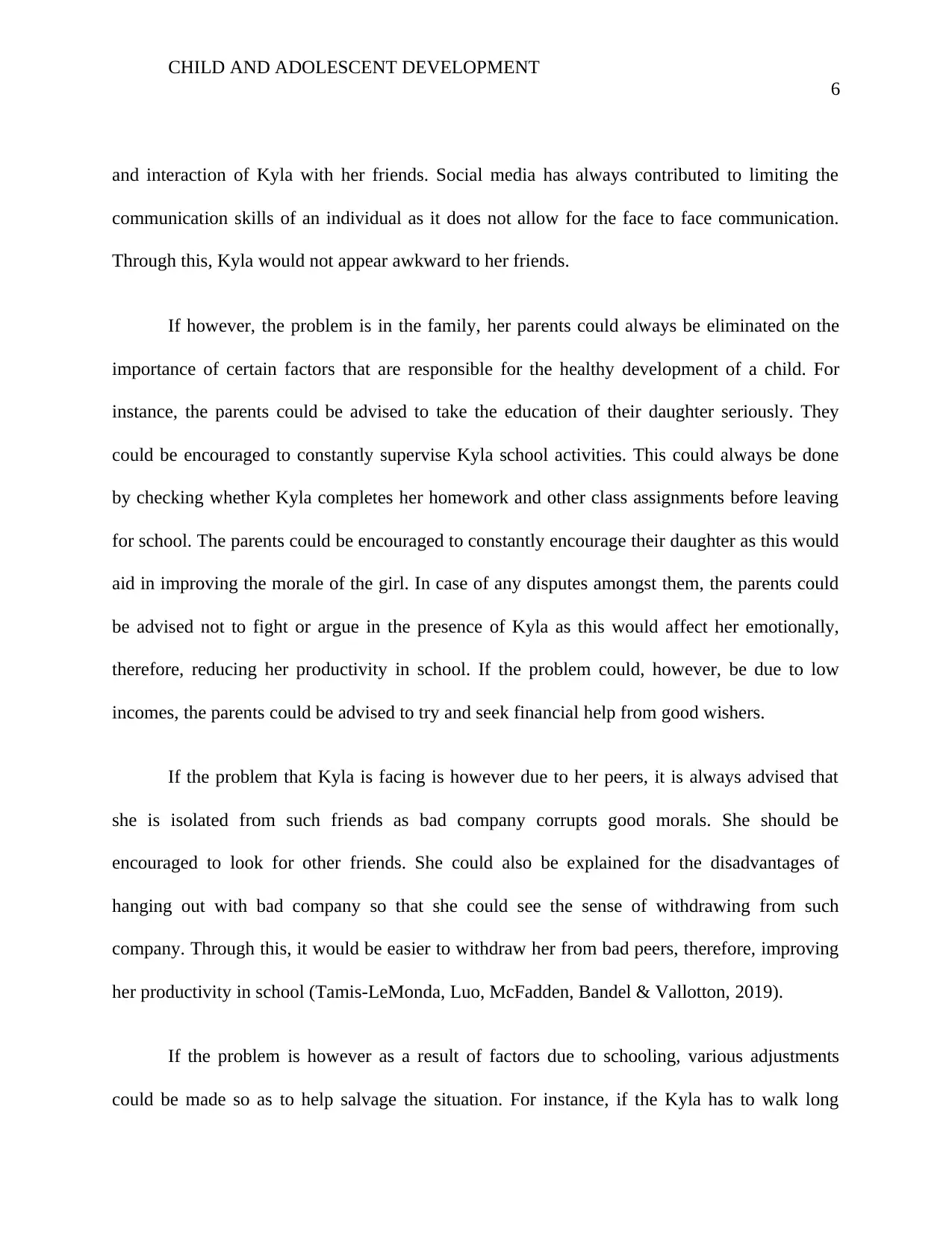
CHILD AND ADOLESCENT DEVELOPMENT
6
and interaction of Kyla with her friends. Social media has always contributed to limiting the
communication skills of an individual as it does not allow for the face to face communication.
Through this, Kyla would not appear awkward to her friends.
If however, the problem is in the family, her parents could always be eliminated on the
importance of certain factors that are responsible for the healthy development of a child. For
instance, the parents could be advised to take the education of their daughter seriously. They
could be encouraged to constantly supervise Kyla school activities. This could always be done
by checking whether Kyla completes her homework and other class assignments before leaving
for school. The parents could be encouraged to constantly encourage their daughter as this would
aid in improving the morale of the girl. In case of any disputes amongst them, the parents could
be advised not to fight or argue in the presence of Kyla as this would affect her emotionally,
therefore, reducing her productivity in school. If the problem could, however, be due to low
incomes, the parents could be advised to try and seek financial help from good wishers.
If the problem that Kyla is facing is however due to her peers, it is always advised that
she is isolated from such friends as bad company corrupts good morals. She should be
encouraged to look for other friends. She could also be explained for the disadvantages of
hanging out with bad company so that she could see the sense of withdrawing from such
company. Through this, it would be easier to withdraw her from bad peers, therefore, improving
her productivity in school (Tamis-LeMonda, Luo, McFadden, Bandel & Vallotton, 2019).
If the problem is however as a result of factors due to schooling, various adjustments
could be made so as to help salvage the situation. For instance, if the Kyla has to walk long
6
and interaction of Kyla with her friends. Social media has always contributed to limiting the
communication skills of an individual as it does not allow for the face to face communication.
Through this, Kyla would not appear awkward to her friends.
If however, the problem is in the family, her parents could always be eliminated on the
importance of certain factors that are responsible for the healthy development of a child. For
instance, the parents could be advised to take the education of their daughter seriously. They
could be encouraged to constantly supervise Kyla school activities. This could always be done
by checking whether Kyla completes her homework and other class assignments before leaving
for school. The parents could be encouraged to constantly encourage their daughter as this would
aid in improving the morale of the girl. In case of any disputes amongst them, the parents could
be advised not to fight or argue in the presence of Kyla as this would affect her emotionally,
therefore, reducing her productivity in school. If the problem could, however, be due to low
incomes, the parents could be advised to try and seek financial help from good wishers.
If the problem that Kyla is facing is however due to her peers, it is always advised that
she is isolated from such friends as bad company corrupts good morals. She should be
encouraged to look for other friends. She could also be explained for the disadvantages of
hanging out with bad company so that she could see the sense of withdrawing from such
company. Through this, it would be easier to withdraw her from bad peers, therefore, improving
her productivity in school (Tamis-LeMonda, Luo, McFadden, Bandel & Vallotton, 2019).
If the problem is however as a result of factors due to schooling, various adjustments
could be made so as to help salvage the situation. For instance, if the Kyla has to walk long
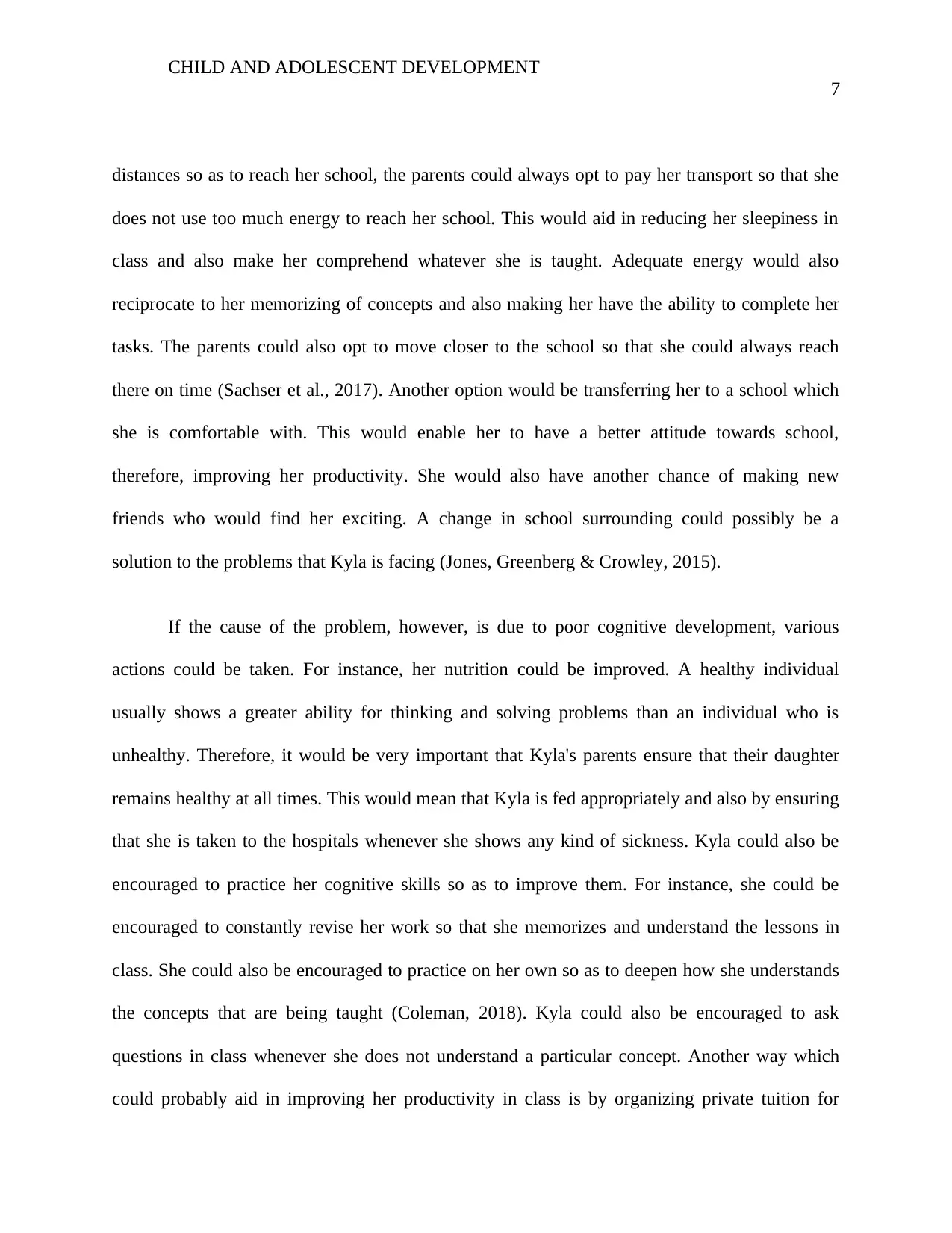
CHILD AND ADOLESCENT DEVELOPMENT
7
distances so as to reach her school, the parents could always opt to pay her transport so that she
does not use too much energy to reach her school. This would aid in reducing her sleepiness in
class and also make her comprehend whatever she is taught. Adequate energy would also
reciprocate to her memorizing of concepts and also making her have the ability to complete her
tasks. The parents could also opt to move closer to the school so that she could always reach
there on time (Sachser et al., 2017). Another option would be transferring her to a school which
she is comfortable with. This would enable her to have a better attitude towards school,
therefore, improving her productivity. She would also have another chance of making new
friends who would find her exciting. A change in school surrounding could possibly be a
solution to the problems that Kyla is facing (Jones, Greenberg & Crowley, 2015).
If the cause of the problem, however, is due to poor cognitive development, various
actions could be taken. For instance, her nutrition could be improved. A healthy individual
usually shows a greater ability for thinking and solving problems than an individual who is
unhealthy. Therefore, it would be very important that Kyla's parents ensure that their daughter
remains healthy at all times. This would mean that Kyla is fed appropriately and also by ensuring
that she is taken to the hospitals whenever she shows any kind of sickness. Kyla could also be
encouraged to practice her cognitive skills so as to improve them. For instance, she could be
encouraged to constantly revise her work so that she memorizes and understand the lessons in
class. She could also be encouraged to practice on her own so as to deepen how she understands
the concepts that are being taught (Coleman, 2018). Kyla could also be encouraged to ask
questions in class whenever she does not understand a particular concept. Another way which
could probably aid in improving her productivity in class is by organizing private tuition for
7
distances so as to reach her school, the parents could always opt to pay her transport so that she
does not use too much energy to reach her school. This would aid in reducing her sleepiness in
class and also make her comprehend whatever she is taught. Adequate energy would also
reciprocate to her memorizing of concepts and also making her have the ability to complete her
tasks. The parents could also opt to move closer to the school so that she could always reach
there on time (Sachser et al., 2017). Another option would be transferring her to a school which
she is comfortable with. This would enable her to have a better attitude towards school,
therefore, improving her productivity. She would also have another chance of making new
friends who would find her exciting. A change in school surrounding could possibly be a
solution to the problems that Kyla is facing (Jones, Greenberg & Crowley, 2015).
If the cause of the problem, however, is due to poor cognitive development, various
actions could be taken. For instance, her nutrition could be improved. A healthy individual
usually shows a greater ability for thinking and solving problems than an individual who is
unhealthy. Therefore, it would be very important that Kyla's parents ensure that their daughter
remains healthy at all times. This would mean that Kyla is fed appropriately and also by ensuring
that she is taken to the hospitals whenever she shows any kind of sickness. Kyla could also be
encouraged to practice her cognitive skills so as to improve them. For instance, she could be
encouraged to constantly revise her work so that she memorizes and understand the lessons in
class. She could also be encouraged to practice on her own so as to deepen how she understands
the concepts that are being taught (Coleman, 2018). Kyla could also be encouraged to ask
questions in class whenever she does not understand a particular concept. Another way which
could probably aid in improving her productivity in class is by organizing private tuition for
Paraphrase This Document
Need a fresh take? Get an instant paraphrase of this document with our AI Paraphraser
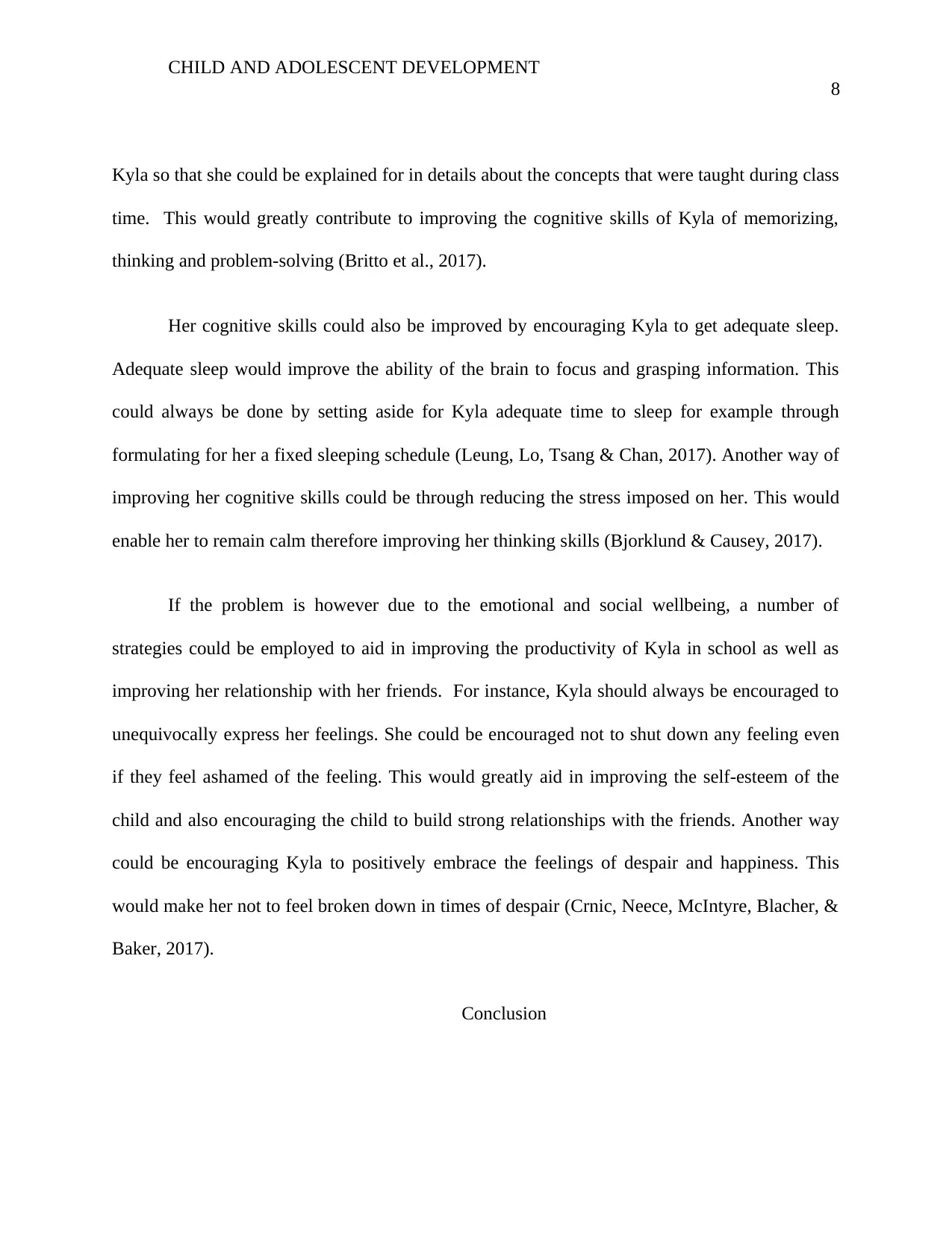
CHILD AND ADOLESCENT DEVELOPMENT
8
Kyla so that she could be explained for in details about the concepts that were taught during class
time. This would greatly contribute to improving the cognitive skills of Kyla of memorizing,
thinking and problem-solving (Britto et al., 2017).
Her cognitive skills could also be improved by encouraging Kyla to get adequate sleep.
Adequate sleep would improve the ability of the brain to focus and grasping information. This
could always be done by setting aside for Kyla adequate time to sleep for example through
formulating for her a fixed sleeping schedule (Leung, Lo, Tsang & Chan, 2017). Another way of
improving her cognitive skills could be through reducing the stress imposed on her. This would
enable her to remain calm therefore improving her thinking skills (Bjorklund & Causey, 2017).
If the problem is however due to the emotional and social wellbeing, a number of
strategies could be employed to aid in improving the productivity of Kyla in school as well as
improving her relationship with her friends. For instance, Kyla should always be encouraged to
unequivocally express her feelings. She could be encouraged not to shut down any feeling even
if they feel ashamed of the feeling. This would greatly aid in improving the self-esteem of the
child and also encouraging the child to build strong relationships with the friends. Another way
could be encouraging Kyla to positively embrace the feelings of despair and happiness. This
would make her not to feel broken down in times of despair (Crnic, Neece, McIntyre, Blacher, &
Baker, 2017).
Conclusion
8
Kyla so that she could be explained for in details about the concepts that were taught during class
time. This would greatly contribute to improving the cognitive skills of Kyla of memorizing,
thinking and problem-solving (Britto et al., 2017).
Her cognitive skills could also be improved by encouraging Kyla to get adequate sleep.
Adequate sleep would improve the ability of the brain to focus and grasping information. This
could always be done by setting aside for Kyla adequate time to sleep for example through
formulating for her a fixed sleeping schedule (Leung, Lo, Tsang & Chan, 2017). Another way of
improving her cognitive skills could be through reducing the stress imposed on her. This would
enable her to remain calm therefore improving her thinking skills (Bjorklund & Causey, 2017).
If the problem is however due to the emotional and social wellbeing, a number of
strategies could be employed to aid in improving the productivity of Kyla in school as well as
improving her relationship with her friends. For instance, Kyla should always be encouraged to
unequivocally express her feelings. She could be encouraged not to shut down any feeling even
if they feel ashamed of the feeling. This would greatly aid in improving the self-esteem of the
child and also encouraging the child to build strong relationships with the friends. Another way
could be encouraging Kyla to positively embrace the feelings of despair and happiness. This
would make her not to feel broken down in times of despair (Crnic, Neece, McIntyre, Blacher, &
Baker, 2017).
Conclusion
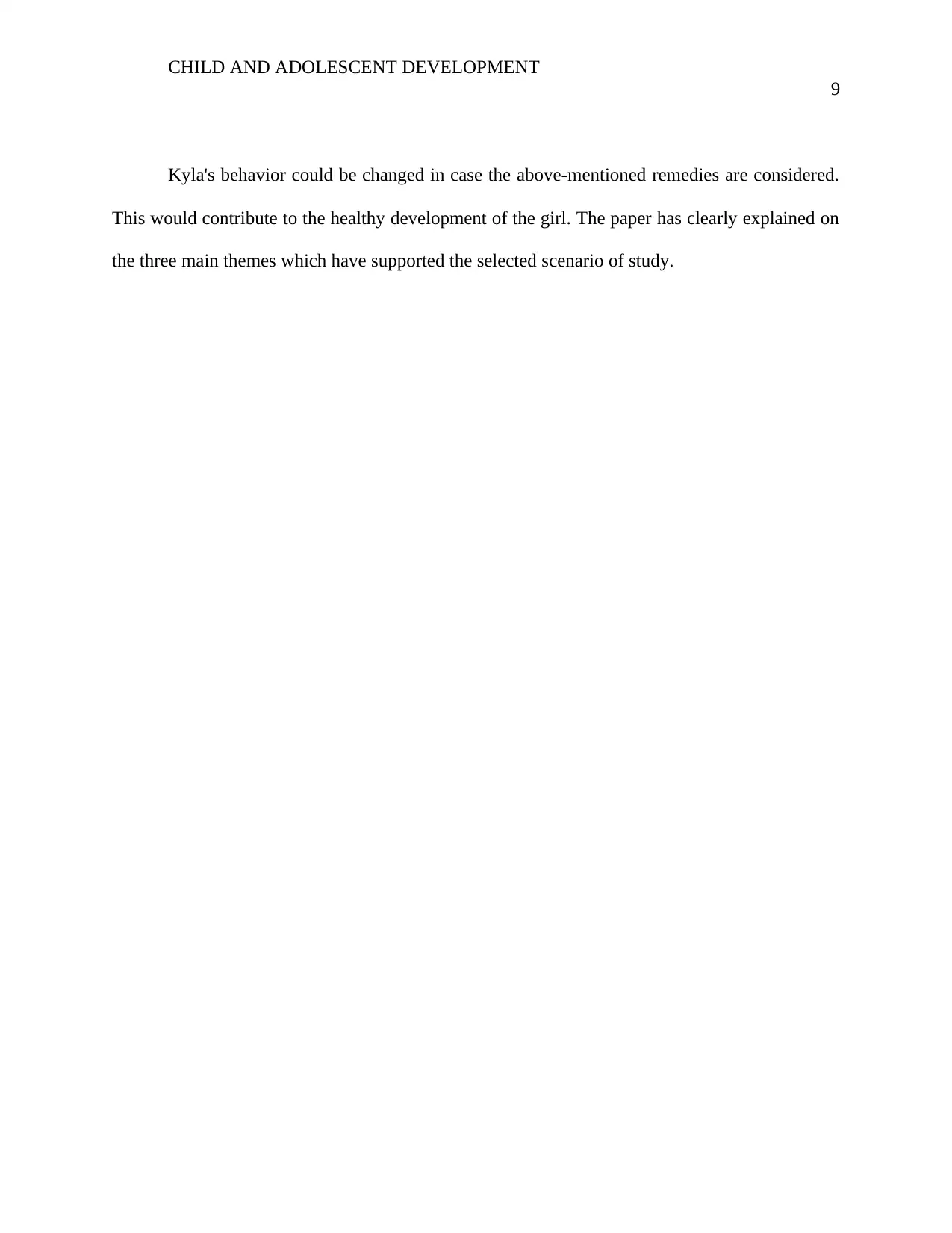
CHILD AND ADOLESCENT DEVELOPMENT
9
Kyla's behavior could be changed in case the above-mentioned remedies are considered.
This would contribute to the healthy development of the girl. The paper has clearly explained on
the three main themes which have supported the selected scenario of study.
9
Kyla's behavior could be changed in case the above-mentioned remedies are considered.
This would contribute to the healthy development of the girl. The paper has clearly explained on
the three main themes which have supported the selected scenario of study.
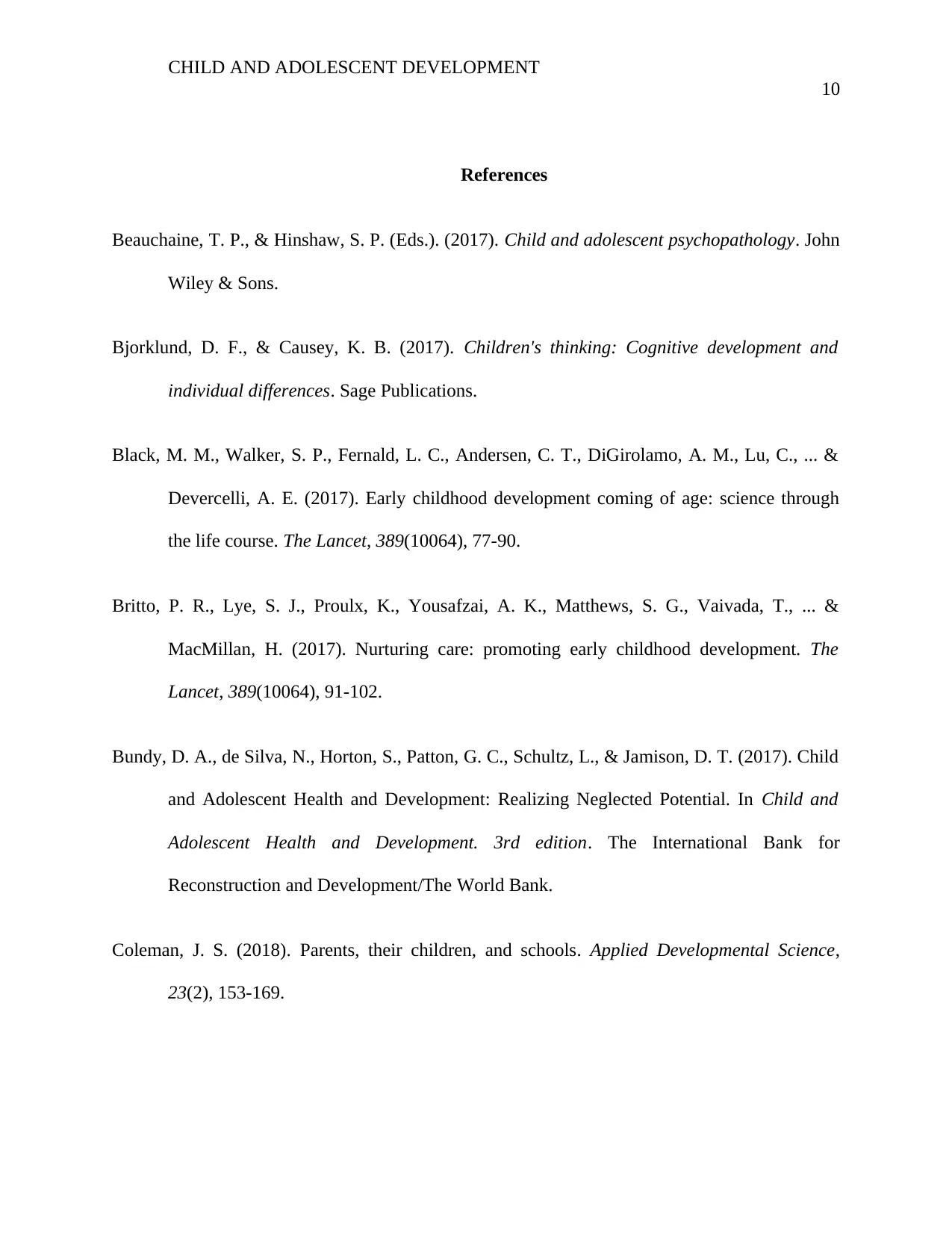
CHILD AND ADOLESCENT DEVELOPMENT
10
References
Beauchaine, T. P., & Hinshaw, S. P. (Eds.). (2017). Child and adolescent psychopathology. John
Wiley & Sons.
Bjorklund, D. F., & Causey, K. B. (2017). Children's thinking: Cognitive development and
individual differences. Sage Publications.
Black, M. M., Walker, S. P., Fernald, L. C., Andersen, C. T., DiGirolamo, A. M., Lu, C., ... &
Devercelli, A. E. (2017). Early childhood development coming of age: science through
the life course. The Lancet, 389(10064), 77-90.
Britto, P. R., Lye, S. J., Proulx, K., Yousafzai, A. K., Matthews, S. G., Vaivada, T., ... &
MacMillan, H. (2017). Nurturing care: promoting early childhood development. The
Lancet, 389(10064), 91-102.
Bundy, D. A., de Silva, N., Horton, S., Patton, G. C., Schultz, L., & Jamison, D. T. (2017). Child
and Adolescent Health and Development: Realizing Neglected Potential. In Child and
Adolescent Health and Development. 3rd edition. The International Bank for
Reconstruction and Development/The World Bank.
Coleman, J. S. (2018). Parents, their children, and schools. Applied Developmental Science,
23(2), 153-169.
10
References
Beauchaine, T. P., & Hinshaw, S. P. (Eds.). (2017). Child and adolescent psychopathology. John
Wiley & Sons.
Bjorklund, D. F., & Causey, K. B. (2017). Children's thinking: Cognitive development and
individual differences. Sage Publications.
Black, M. M., Walker, S. P., Fernald, L. C., Andersen, C. T., DiGirolamo, A. M., Lu, C., ... &
Devercelli, A. E. (2017). Early childhood development coming of age: science through
the life course. The Lancet, 389(10064), 77-90.
Britto, P. R., Lye, S. J., Proulx, K., Yousafzai, A. K., Matthews, S. G., Vaivada, T., ... &
MacMillan, H. (2017). Nurturing care: promoting early childhood development. The
Lancet, 389(10064), 91-102.
Bundy, D. A., de Silva, N., Horton, S., Patton, G. C., Schultz, L., & Jamison, D. T. (2017). Child
and Adolescent Health and Development: Realizing Neglected Potential. In Child and
Adolescent Health and Development. 3rd edition. The International Bank for
Reconstruction and Development/The World Bank.
Coleman, J. S. (2018). Parents, their children, and schools. Applied Developmental Science,
23(2), 153-169.
Secure Best Marks with AI Grader
Need help grading? Try our AI Grader for instant feedback on your assignments.
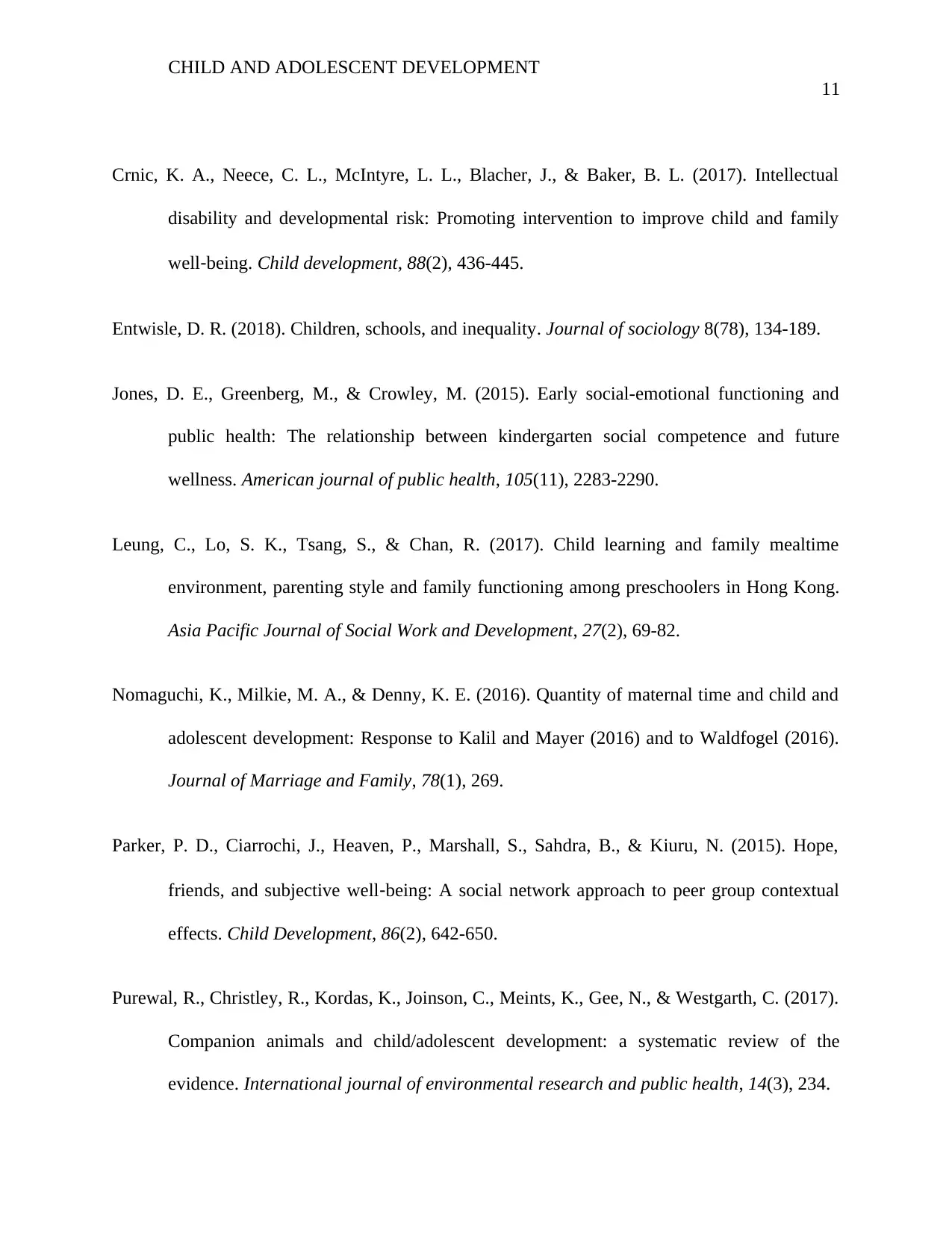
CHILD AND ADOLESCENT DEVELOPMENT
11
Crnic, K. A., Neece, C. L., McIntyre, L. L., Blacher, J., & Baker, B. L. (2017). Intellectual
disability and developmental risk: Promoting intervention to improve child and family
well‐being. Child development, 88(2), 436-445.
Entwisle, D. R. (2018). Children, schools, and inequality. Journal of sociology 8(78), 134-189.
Jones, D. E., Greenberg, M., & Crowley, M. (2015). Early social-emotional functioning and
public health: The relationship between kindergarten social competence and future
wellness. American journal of public health, 105(11), 2283-2290.
Leung, C., Lo, S. K., Tsang, S., & Chan, R. (2017). Child learning and family mealtime
environment, parenting style and family functioning among preschoolers in Hong Kong.
Asia Pacific Journal of Social Work and Development, 27(2), 69-82.
Nomaguchi, K., Milkie, M. A., & Denny, K. E. (2016). Quantity of maternal time and child and
adolescent development: Response to Kalil and Mayer (2016) and to Waldfogel (2016).
Journal of Marriage and Family, 78(1), 269.
Parker, P. D., Ciarrochi, J., Heaven, P., Marshall, S., Sahdra, B., & Kiuru, N. (2015). Hope,
friends, and subjective well‐being: A social network approach to peer group contextual
effects. Child Development, 86(2), 642-650.
Purewal, R., Christley, R., Kordas, K., Joinson, C., Meints, K., Gee, N., & Westgarth, C. (2017).
Companion animals and child/adolescent development: a systematic review of the
evidence. International journal of environmental research and public health, 14(3), 234.
11
Crnic, K. A., Neece, C. L., McIntyre, L. L., Blacher, J., & Baker, B. L. (2017). Intellectual
disability and developmental risk: Promoting intervention to improve child and family
well‐being. Child development, 88(2), 436-445.
Entwisle, D. R. (2018). Children, schools, and inequality. Journal of sociology 8(78), 134-189.
Jones, D. E., Greenberg, M., & Crowley, M. (2015). Early social-emotional functioning and
public health: The relationship between kindergarten social competence and future
wellness. American journal of public health, 105(11), 2283-2290.
Leung, C., Lo, S. K., Tsang, S., & Chan, R. (2017). Child learning and family mealtime
environment, parenting style and family functioning among preschoolers in Hong Kong.
Asia Pacific Journal of Social Work and Development, 27(2), 69-82.
Nomaguchi, K., Milkie, M. A., & Denny, K. E. (2016). Quantity of maternal time and child and
adolescent development: Response to Kalil and Mayer (2016) and to Waldfogel (2016).
Journal of Marriage and Family, 78(1), 269.
Parker, P. D., Ciarrochi, J., Heaven, P., Marshall, S., Sahdra, B., & Kiuru, N. (2015). Hope,
friends, and subjective well‐being: A social network approach to peer group contextual
effects. Child Development, 86(2), 642-650.
Purewal, R., Christley, R., Kordas, K., Joinson, C., Meints, K., Gee, N., & Westgarth, C. (2017).
Companion animals and child/adolescent development: a systematic review of the
evidence. International journal of environmental research and public health, 14(3), 234.
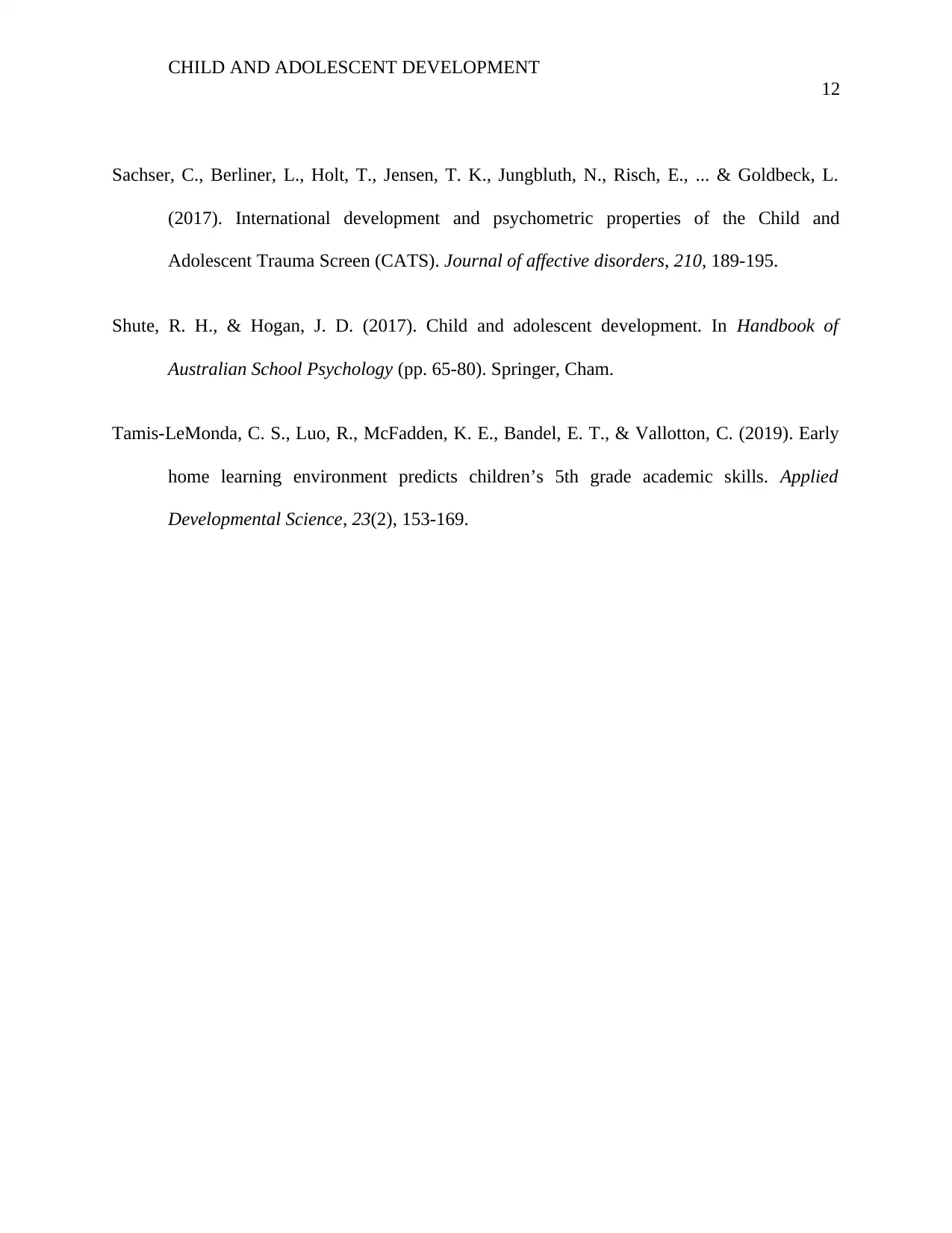
CHILD AND ADOLESCENT DEVELOPMENT
12
Sachser, C., Berliner, L., Holt, T., Jensen, T. K., Jungbluth, N., Risch, E., ... & Goldbeck, L.
(2017). International development and psychometric properties of the Child and
Adolescent Trauma Screen (CATS). Journal of affective disorders, 210, 189-195.
Shute, R. H., & Hogan, J. D. (2017). Child and adolescent development. In Handbook of
Australian School Psychology (pp. 65-80). Springer, Cham.
Tamis-LeMonda, C. S., Luo, R., McFadden, K. E., Bandel, E. T., & Vallotton, C. (2019). Early
home learning environment predicts children’s 5th grade academic skills. Applied
Developmental Science, 23(2), 153-169.
12
Sachser, C., Berliner, L., Holt, T., Jensen, T. K., Jungbluth, N., Risch, E., ... & Goldbeck, L.
(2017). International development and psychometric properties of the Child and
Adolescent Trauma Screen (CATS). Journal of affective disorders, 210, 189-195.
Shute, R. H., & Hogan, J. D. (2017). Child and adolescent development. In Handbook of
Australian School Psychology (pp. 65-80). Springer, Cham.
Tamis-LeMonda, C. S., Luo, R., McFadden, K. E., Bandel, E. T., & Vallotton, C. (2019). Early
home learning environment predicts children’s 5th grade academic skills. Applied
Developmental Science, 23(2), 153-169.
1 out of 12
Related Documents
Your All-in-One AI-Powered Toolkit for Academic Success.
+13062052269
info@desklib.com
Available 24*7 on WhatsApp / Email
![[object Object]](/_next/static/media/star-bottom.7253800d.svg)
Unlock your academic potential
© 2024 | Zucol Services PVT LTD | All rights reserved.





